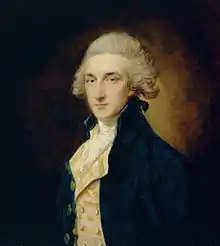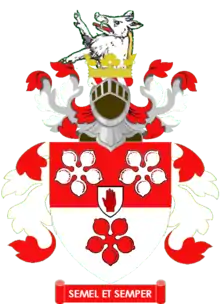Sir John Swinburne, 6th Baronet
Sir John Swinburne, 6th Baronet (6 March 1762 – 26 September 1860) was an English politician and patron of the arts.

Life
He was born at Bordeaux. The Swinburne family of Capheaton Hall was traditionally Roman Catholic and Jacobite, but at age 25 Swinburne inherited the baronetcy and went into politics as a Protestant Whig. He became Member of Parliament for Launceston in 1788.[1] There was a vacancy there, because the sitting MP George Rose had accepted an office under the Crown, and had to step down;[2] Swinburne from 1786 had intended to stand for Northumberland, but Hugh Percy, 2nd Duke of Northumberland managed his selection for the Cornwall constituency.[3] He went no further in Parliament, but remained a political leader in Northumberland, and an associate of Charles Grey who was elected for the constituency in 1786.[4]
Swinburne completed the work on the north front of Capheaton Hall envisaged by his father. It was carried out by William Newton.[5][6]
He was a Fellow of the Royal Society, Fellow of the Society of Antiquaries of London, and the first president of the Society of Antiquaries of Newcastle upon Tyne.[7][8]
Patron
He was a patron to William Mulready: they shared an enthusiasm for boxing. Mulready taught the Swinburne family and painted their portraits.[9] He also supported John Hodgson, who referred in his History of Northumberland to Swinburne as a "munificent contributor to the embellishments and materials of this work".[10]
Family
He married Emma, daughter of Richard Henry Alexander Bennet of Babraham, Cambridgeshire, on 13 July 1787; she was a niece of Frances Julia (née Burrell, daughter of Peter Burrell), second wife of the 2nd Duke of Northumberland. Their children were:
- Edward (1788–1819), who married Anne Nassau Sutton;
- Charles Henry (1797–1877), Royal Navy officer; he married Jane Henrietta, daughter of George Ashburnham, 3rd Earl of Ashburnham, and they had six children, of whom the second was the poet Algernon Charles Swinburne.[11]
- Elizabeth (1790–1790);
- Julia (1795–);
- Emily Elizabeth (1798– ), who married Henry George Ward in 1824;
- Frances (1799–1821);
- Elizabeth (1805–1896), married John William Bowden in 1828.[12][13]
Arms
 |
|
Notes
- Philip Henderson, Swinburne: the portrait of a poet (1976), p. 6; Google Books.
- historyofparliamentonline.org, Launceston, 1754-1790.
- Roland G. Thorne, The House of Commons 1790-1820 (1986), p. 303; Google Books.
- historyofparliamentonline.org, Percy, Hugh, Earl Percy (1785-1847).
- Capheaton Hall site, History.
- Images of England page.
- Philosophical Transactions Part 2 (1833), Royal Society of London, p. 48; Google Books.
- "First Annual Report of the Antiquarian Society of Newcastle upont Tyne (being for the year 1813)". Archaeologia Aeliana. 1st Series (1): 800–806. 1822.
- Pointon, Marcia. "Mulready, William". Oxford Dictionary of National Biography (online ed.). Oxford University Press. doi:10.1093/ref:odnb/19520. (Subscription or UK public library membership required.)
- John Hodgson, A History of Northumberland, in three parts, Part 2, Volume 1 (1827), p. 234; Google Books.
- Rooksby, Rikky. "Swinburne, Algernon Charles". Oxford Dictionary of National Biography (online ed.). Oxford University Press. doi:10.1093/ref:odnb/36389. (Subscription or UK public library membership required.)
- John Debrett, Debrett's Baronetage of England (1835) p. 95; archive.org.
- William James Gordon-Gorman, Converts to Rome: a biographical list of the more notable converts to the Catholic Church in the United Kingdom during the last sixty years (1910), p. 28; archive.org.
- Debrett's peerage, baronetage, knightage, and companionage. 1893.
| Baronetage of England | ||
|---|---|---|
| Preceded by Edward Swinburne |
Baronet (of Capheaton) 1786–1860 |
Succeeded by John Swinburne |